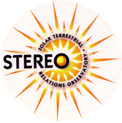HET Data and Plots
ASCII Data Files
- Ahead
- Behind
SEP Electron Event Lists
Lists of SEP electron events and data from STEREO HET A and B. Links to selected figures as well as machine-readable (.txt and .csv) versions of the web pages are also included.
Biweekly Time-series Survey Plots
HET Data Documentation
The current release of HET data consists of 1-minute, 15-minute, Hourly, 12-hour, and Daily averaged electron and proton intensities. The intensity units are particles/(cm2-sr-sec-MeV), and intensities in the following energy ranges are provided:
- electrons: 0.7-1.4, 1.4-2.8, 2.8-4.0 MeV
- protons: 13.6-15.1, 14.9-17.1, 17.0-19.3, 20.8-23.8, 23.8-26.4, 26.3-29.7, 29.5-33.4, 33.4-35.8, 35.5-40.5, 40.0-60.0, 60.0-100.0 MeV
Caveats and Warnings
The calibration of the HET electron channels is not currently correct, and data from this website or other sources should not be used directly for estimating electron/proton intensity ratios or deriving electron spectra. Lario et al. (Astrophys. J. 767, 41. 2013) and Richardson et al. (Solar Physics 289:3059, 2014) concluded that the summed 0.7-4 MeV electron intensities were low by a factor of ~15 when compared with measurements made by other instruments when the STEREO spacecraft were near Earth during the SEP events in December 2006. However, the corrections for individual electron channels, and whether the electron calibration has drifted during the mission, have not been determined.
These data do not have any background corrections applied. There may be significant background contributions during solar quiet times, but it is not expected that these contributions are important during periods when the count rates are well above their minimum levels.
Data gaps in these HET files are not filled.
File Format Description
The files have names like BeH07Dec.15m (which can be parsed as spacecraft B, electrons and protons, 2007 December, 15minute averages).
There is a header in each file which ends with the line '#End'. The header can be used to infer the data contained in the file; each subsequent line in the file, if it doesn't start with ';' , represents a date record; lines starting with a ';' are comment lines.
The information in the file header can be parsed as follows:
line 1 ASCII
line 2 comment (without ; )
line 3 start date/time for the data in the file
line 4 end date/time for the data in the file
line 5 ignore this line
line 6 #0 Rate - signifies the start of definition for verse 0; each data record starts with its verse number; in the present case the only verse which appears is verse 0
line 7 If "T2" is present in the 1st field of this line, then both a start and end time will be given for each record.
If "T1" is present in the 1st field, then only a start time will be given for each record.
After line 7, each header line defines a pair of intensity/uncertainty values that appears in each data record. For example:
line 8 "F2 1e-005 5e+005 0.7 1.4 e" Indicates that there will be a value given for electron intensity with energies between 0.7 and 1.4 MeV, followed by the uncertainty (1 sigma) for this intensity
...
...
line 11 "F2 1e-005 5e+005 13.6 15.1 H" similar to line 8 but for 13.6 to 15.1 MeV protons
Spelling this out in more detail...After the file header, the data records in teh electron/proton files are defined as follows:
Column 1: Verse number (always '0')
Columns 2,3,4,5: Start date/time
Columns 6,7,8,9: End date/time NOTE: for the 1-minute data files, these End date/time columns ARE NOT PRESENT (T1 in line 7)
Column 10: Electron flux, 0.7 - 1.4 MeV, particles/(cm2-sr-sec-MeV)
Column 11: Uncertainty (sigma) for 0.7 - 1.4 MeV electron flux
Column 12: Electron flux, 1.4 - 2.8 MeV, particles/(cm2-sr-sec-MeV)
Column 13: Uncertainty (sigma) for 1.4 - 2.8 MeV electron flux
Column 14: Electron flux, 2.8 - 4.0 MeV, particles/(cm2-sr-sec-MeV)
Column 15: Uncertainty (sigma) for 2.8 - 4.0 MeV electron flux
Column 16: Proton flux, 13.6-15.1 MeV, particles/(cm2-sr-sec-MeV)
Column 17 Uncertainty (sigma) for 13.6-15.1 MeV proton flux
Column 18: Proton flux, 14.9-17.1 MeV, particles/(cm2-sr-sec-MeV)
Column 19: Uncertainty (sigma) for 14.9-17.1 MeV proton flux
and so on....
The HET design, calibration and operation is described in detail in a Space Science Reviews paper by von Rosenvinge et al. (2008).
Other potentially useful HET and SEP-suite docs
